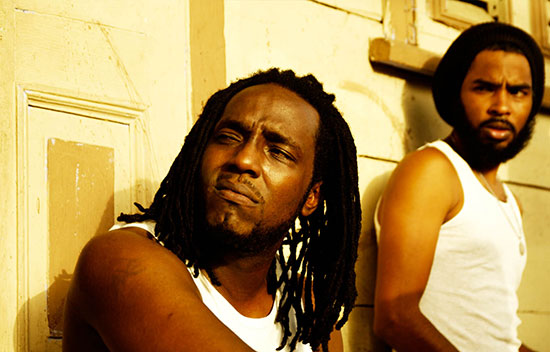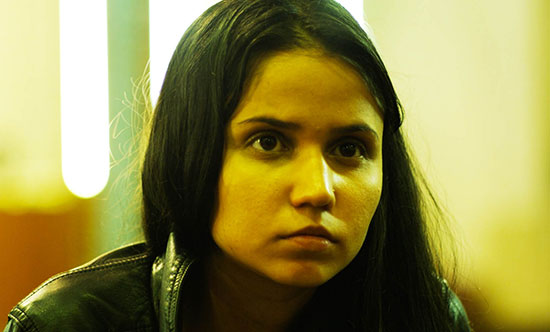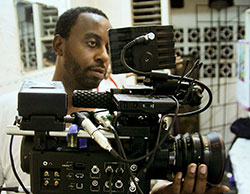Everybody loves The Fighter
04/12/14 09:10 Filed in: Reviews
Originally published in the Trinidad Guardian for November 04, 2014

Abdi Waithe and Muhammad Muwakil in a scene from God Loves the Fighter. Photographs courtesy the production.
The public reaction to Damian Marcano’s gritty urban drama, God Loves the Fighter is a matter of record.
Released for public viewing as part of the 2013 Film Festival, the bleak story of the T&T underclass was the toast of the festival, winning the People’s Choice award and ended up squeezed into every available free screen to satisfy public demand.
There is much that is compelling about the film. It features a top flight cast of performers, less than half of whom are actual actors as a first profession.
The Freetown Collective’s Muhammad Muwakil headlines as Charlie and Lou Lyons is the rap poet Greek chorus of the film, the vagrant King Curtis.
Darren Cheewah turns in a riveting and courageous performance as druglord and whoremonger Putao, dressed in his first onscreen appearance in red underwear and tattoos.
Abdi Waithe is a compelling Stone, the truly amoral dark drainhole of the film around whom everything appears to swirl and disappear.
Jaime-Lee Phillips, a popular model, is so staggeringly miscast as a well-meaning prostitute (named Dinah, with some shameless bravado) that she comes right around to the other side of her role and seemed ripe for a dramatic backstory that puts a pretty girl on her back on the streets.
Like so much that God Loves the Fighter promises, very little of it actually arrives in any satisfactory way.
Veteran actors Penelope Spencer, Albert La Veau and Errol Sitahal invest their roles with significant gravitas, but seemed confused about their story arcs, unsure of where to place the weight of their performances and how to measure them out across the film.
The smoky, lurid contrast of the film quickly becomes tiresome, the deep blacks and extreme colour grading that so dramatically define the film’s first scenes eventually becoming the most consistently oppressive element of the production.
But it’s a heavy-handed treatment that only serves to obscure the details that director Damian Marcano is trying to reveal.
Shot in 2011, largely during the state of emergency declared by Prime Minister Kamla Persad-Bissessar, the film succeeds in offering a disturbing portrait of Port of Spain as a dark and brooding necropolis.
In one remarkable scene, Stone cross-examines Charlie’s vague hope of getting out of “the life” and doing something more. His derisive laughter at the notion of Charlie going to a nine to five job is easily one of the most disturbing moments in the film, ringing true with troubling resonance.
Another scene, which finds Charlie sitting out on a rooftop ledge after an aborted assignation with a “church girl,” also has the feel of honest recollection, but such moments feel rare in a film that’s so determined to plumb the reasons for the city’s pervasive crime and its undeniable temptations.
In God Loves the Fighter, horrors wash over the diesnfranchised relentlessly and without mercy, a terrible tidal wave of greed and ruthlessness.
The film’s deus ex machina comes when Charlie eventually finds himself pushed too far, beyond his bitter tolerance of Putao’s casual racism into a sexual exploitation even he cannot stomach.
God, in this film, actually doesn’t love the fighters and only an irrational act of caring spares one innocent from the punishment of the streets.

Jaime Lee Phillips plays Dinah in God Loves the Fighter.
Fighter vs Warlock
It’s a little surprising to find within a year of each other, two energetic examinations of T&T criminal underculture emerging on local screens. The two films, Damian Marcano’s God Loves the Fighter and Jeffrey Alleyne’s Welcome to Warlock enjoyed quite different fortunes.
 A production still of Damian Marcano working on God Loves the Fighter
A production still of Damian Marcano working on God Loves the Fighter
Marcano rode a strong welcome at the T&T Film Festival to cinematic release this week. Alleyne released Warlock on DVD and triggered a paroxysm of piracy that gutted his income from the film.
But there’s more that differs between the two films and those differences are worth considering.
Marcano is revisiting his youth on the streets in his film from the perspective of the success that he’s enjoyed after leaving it. There’s grit to the resulting film, but it’s a veneer over a rediscovery of and romance with the idea of ghetto culture.
That leads to traditional story arcs and character tropes; the good whore and the bad boy struggling to make good as attractive leads, the colourful drug lord, the theatrical fascination with guns.
These give international audiences familiar hooks to follow in the film, though the subtitles are irritatingly riddled with typos.
Warlock offers no such concessions. Alleyne delivers his film from the point of view of a bad boy still struggling to make good. He’s done time, been in the life and is still fighting for the mainstream acceptance that Marcano has won through a far more careful and measured strategy.
In the films, the resulting differences in their perspectives is dramatic. The subject matter is similar, but Marcano is tunneling into a subculture while Alleyne’s uses his work to find a way out out.
Warlock followed Fighter in the local market and might be described as a me-too effort, but it’s far more than that.
With its mercurial tempers, its casual use of guns as part of street vocabulary and its insane tangents of violence, it rings truer as a fictional exploration of modern T&T street crime.
And Warlock’s eventual fate on the streets, a victim of casual but staggeringly sustained intellectual property theft, is a reminder that this can be a cruel country for dreamers as well as fighters.

Abdi Waithe and Muhammad Muwakil in a scene from God Loves the Fighter. Photographs courtesy the production.
The public reaction to Damian Marcano’s gritty urban drama, God Loves the Fighter is a matter of record.
Released for public viewing as part of the 2013 Film Festival, the bleak story of the T&T underclass was the toast of the festival, winning the People’s Choice award and ended up squeezed into every available free screen to satisfy public demand.
There is much that is compelling about the film. It features a top flight cast of performers, less than half of whom are actual actors as a first profession.
The Freetown Collective’s Muhammad Muwakil headlines as Charlie and Lou Lyons is the rap poet Greek chorus of the film, the vagrant King Curtis.
Darren Cheewah turns in a riveting and courageous performance as druglord and whoremonger Putao, dressed in his first onscreen appearance in red underwear and tattoos.
Abdi Waithe is a compelling Stone, the truly amoral dark drainhole of the film around whom everything appears to swirl and disappear.
Jaime-Lee Phillips, a popular model, is so staggeringly miscast as a well-meaning prostitute (named Dinah, with some shameless bravado) that she comes right around to the other side of her role and seemed ripe for a dramatic backstory that puts a pretty girl on her back on the streets.
Like so much that God Loves the Fighter promises, very little of it actually arrives in any satisfactory way.
Veteran actors Penelope Spencer, Albert La Veau and Errol Sitahal invest their roles with significant gravitas, but seemed confused about their story arcs, unsure of where to place the weight of their performances and how to measure them out across the film.
The smoky, lurid contrast of the film quickly becomes tiresome, the deep blacks and extreme colour grading that so dramatically define the film’s first scenes eventually becoming the most consistently oppressive element of the production.
But it’s a heavy-handed treatment that only serves to obscure the details that director Damian Marcano is trying to reveal.
Shot in 2011, largely during the state of emergency declared by Prime Minister Kamla Persad-Bissessar, the film succeeds in offering a disturbing portrait of Port of Spain as a dark and brooding necropolis.
In one remarkable scene, Stone cross-examines Charlie’s vague hope of getting out of “the life” and doing something more. His derisive laughter at the notion of Charlie going to a nine to five job is easily one of the most disturbing moments in the film, ringing true with troubling resonance.
Another scene, which finds Charlie sitting out on a rooftop ledge after an aborted assignation with a “church girl,” also has the feel of honest recollection, but such moments feel rare in a film that’s so determined to plumb the reasons for the city’s pervasive crime and its undeniable temptations.
In God Loves the Fighter, horrors wash over the diesnfranchised relentlessly and without mercy, a terrible tidal wave of greed and ruthlessness.
The film’s deus ex machina comes when Charlie eventually finds himself pushed too far, beyond his bitter tolerance of Putao’s casual racism into a sexual exploitation even he cannot stomach.
God, in this film, actually doesn’t love the fighters and only an irrational act of caring spares one innocent from the punishment of the streets.

Jaime Lee Phillips plays Dinah in God Loves the Fighter.
Fighter vs Warlock
It’s a little surprising to find within a year of each other, two energetic examinations of T&T criminal underculture emerging on local screens. The two films, Damian Marcano’s God Loves the Fighter and Jeffrey Alleyne’s Welcome to Warlock enjoyed quite different fortunes.

Marcano rode a strong welcome at the T&T Film Festival to cinematic release this week. Alleyne released Warlock on DVD and triggered a paroxysm of piracy that gutted his income from the film.
But there’s more that differs between the two films and those differences are worth considering.
Marcano is revisiting his youth on the streets in his film from the perspective of the success that he’s enjoyed after leaving it. There’s grit to the resulting film, but it’s a veneer over a rediscovery of and romance with the idea of ghetto culture.
That leads to traditional story arcs and character tropes; the good whore and the bad boy struggling to make good as attractive leads, the colourful drug lord, the theatrical fascination with guns.
These give international audiences familiar hooks to follow in the film, though the subtitles are irritatingly riddled with typos.
Warlock offers no such concessions. Alleyne delivers his film from the point of view of a bad boy still struggling to make good. He’s done time, been in the life and is still fighting for the mainstream acceptance that Marcano has won through a far more careful and measured strategy.
In the films, the resulting differences in their perspectives is dramatic. The subject matter is similar, but Marcano is tunneling into a subculture while Alleyne’s uses his work to find a way out out.
Warlock followed Fighter in the local market and might be described as a me-too effort, but it’s far more than that.
With its mercurial tempers, its casual use of guns as part of street vocabulary and its insane tangents of violence, it rings truer as a fictional exploration of modern T&T street crime.
And Warlock’s eventual fate on the streets, a victim of casual but staggeringly sustained intellectual property theft, is a reminder that this can be a cruel country for dreamers as well as fighters.
blog comments powered by Disqus